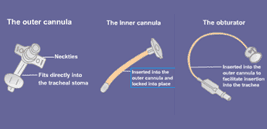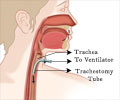Tracheostomy- Post Operative Care
The tube, called a "trach" (trayk) for short, has three parts.

- The "Obturator" that is used to pass the trach into the windpipe.
An "Outer cannula" (tube). This Outer cannula has a plastic "trach plate" that lies against the skin on the neck and holds the trach in place.
- And an "Inner cannula" that fits inside the outer one and locks into place.
- Many of the patients need 1 to 3 days time to adapt themselves to breath through the tracheostomy tube.
- Painkillers and antibiotics are given as per the patients need.
- The patient will have to try and make adjustments to communicate. It would be very difficult for the patient to initially make any noise or sounds let alone trying to speak.
- Most patients can learn to speak with a tracheostomy tube after much training and practice.
- Once the underlying problem that caused the tracheostomy tube to be placed in the first place in healed then the tube would be removed.
- A small scar would remain with the hole healing quickly.
- Long term care for tracheostomy tube
- Patients or attenders should learn how to take care of the tracheostomy if they are to be discharged home after the procedure. This will help them to take care of the tube at home.
- Normal lifestyles are encouraged and most activities can be resumed.
- Some tubes have an inflatable cuff near the outer end to keep them from coming out and to prevent air from leaking around them.
- As long as the tracheostomy tube is in place, the inner cannula should be cleaned on a daily basis.
- Whenever the tube seems like becoming clogged with mucus, it will have to be cleared by suction.
- The procedures are important as a dirty cannula could lead to infection. and if the trach clogs up, the patient will be unable to breath.
- Cleaning and suctioning of the tracheostomy tube must be followed strictly and is perhaps one of the most important instructions given at the time of discharge.









